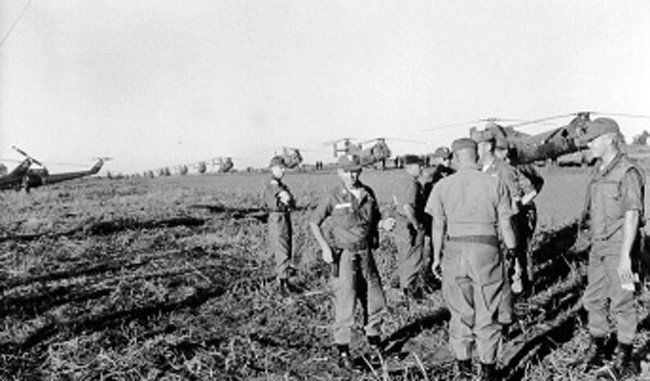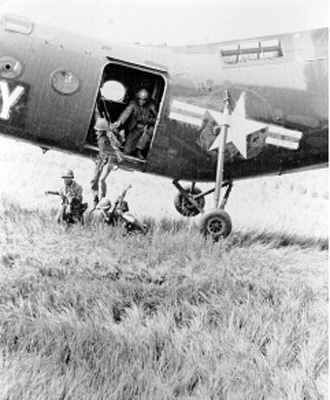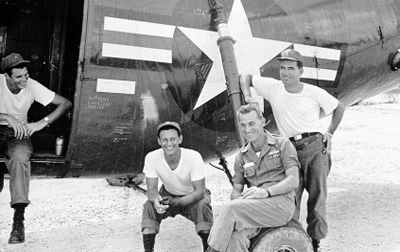Virtual Exhibits
Souvenirs of War
Introduction | Part 1 | Part 2 | Part 3 | Part 4 | Part 5 | Part 6 | Part 7

Photo: Army helicopters with pilots, no date. Photograph by Richard Tregaskis, 1962-1963. Richard Tregaskis Papers.
Richard Tregaskis documented much of the Vietnam War from the air. Spending the majority of his time with marine units heading ARVN (Army of the Republic of Vietnam) troops, Tregaskis usually went along with whatever missions he could attach himself to. Sometimes these missions entailed ambushes in Viet Cong territory, other times supply drops to Vietnamese villagers. While by no means a less dangerous way to experience the war, photographing from a helicopter allowed Tregaskis to remain somewhat distant from the realities of war on the ground. The majority of his ground images are of non-combat situations.

Photo: Troops landing from helicopter. Photograph by Richard Tregaskis, 1962-1963. Richard Tregaskis Papers.
"The crew chief.seemed as enthralled as I with the magnificent, eerie scenery below us. It was unnerving to see the country growing wilder moment by moment, with never a place to put the plane down in those dense trees if there should be an engine failure." (Richard Tregaskis, Vietnam Diary)
Tregaskis began documenting the war in the early 1960s, spending a good deal of time with ARVN (Army of the Republic of Vietnam) troops led by American captains. Several of his photos capture the intensity of the Vietnamese fighting for their country against the Viet Cong.
Richard Tregaskis created many portraits during his time in Vietnam. The majority of portraits from the early to mid-sixties show career military soldiers, aged mainly from the mid-twenties and up. As the war continued into the late 1960s, the effects of the draft and the increasingly younger American GIs who made up the majority of the new recruits are reflected in his photographs. By 1969, the average age of the US Vietnam soldier was nineteen. This trend was not limited to American troops. The average age of the Viet Cong soldier also decreased. Some soldiers were as young as 13 and 14.

Photo: Soldiers relaxing, 1962-1963. Photograph by Richard Tregaskis. Richard Tregaskis Papers.
Many of Tregaskis’ non-combat images include photographs of children, soldiers relaxing, and charitable or goodwill missions. These themes are common in the collection and stand in contrast to the horrors of war documented in the combat images.
By this point in Tregaskis’ life, he had seen more war and insurgency than most humans ever experience. His policy of distance and his tendency to put a positive spin on the experiences he photographed, as well as his complete avoidance of certain negative aspects of the war, is not at all unusual when one considers the amount of war Tregaskis had already experienced by the time he got to Vietnam.
Tregaskis’ second wife, Moana, traveled to Vietnam with him and also took photographs. Moana’s photographs are markedly different from her husband’s. Trained as an anthropologist, Moana’s subject selection is truer to the scientific than the journalistic. Her captions also reveal a more emotional response to the subject matter and information conveyed by the image. In the following photographs of the battle at Luong Phu in the Mekong Delta, it is Moana who photographed the dead bodies of the Viet Cong and reflected on the battle, not Tregaskis.
Introduction | Part 1 | Part 2 | Part 3 | Part 4 | Part 5 | Part 6 | Part 7

